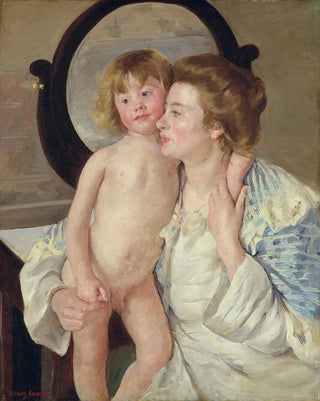Art print | Mother and Child Oval Mirror - Mary Cassatt


View from behind

Frame (optional)
In the enchanting world of Impressionist art, "Mother and Child Oval Mirror" by Mary Cassatt stands out for its intimate and emotive portrayal of motherhood. This artwork, imbued with tenderness, captures a fleeting moment where the relationship between a mother and her child reveals itself in all its depth. Cassatt, as a pioneer, transcends mere representation to offer a delicate and personal vision of family life. The oval mirror, a central element of the composition, acts not only as a physical reflection but also as a symbol of the multiple dimensions of motherhood, inviting the viewer to delve into the intimacy of this sacred bond.
Style and uniqueness of the work
Mary Cassatt's style is characterized by the use of soft colors and fluid brushstrokes, typical of Impressionism. In "Mother and Child Oval Mirror," pastel shades and subtle lighting create a serene, almost dreamlike atmosphere. The artist excels at capturing the nuances of emotions, making palpable the affection between mother and child. The way she plays with reflections in the mirror adds visual depth, while reinforcing the notions of contemplation and introspection. This painting is not limited to a simple domestic scene; it evokes the beauty of everyday moments, celebrating femininity and motherhood with rare sensitivity. Cassatt, by focusing on female subjects, offers a unique perspective that continues to inspire and move.
The artist and her influence
Mary Cassatt, born in 1844, is one of the emblematic figures of Impressionism, often associated with great masters such as Degas and Monet. Her career, marked by a desire to depict women's lives, paved the way for a new understanding of feminine art. Cassatt managed to establish herself in a male-dominated environment, bringing a singular voice to the representation of motherhood and family relationships. Her influence extends well beyond her time; she has inspired many contemporary and future artists to explore similar themes, while claiming an essential place in art history. By integrating elements

Matte finish

View from behind

Frame (optional)
In the enchanting world of Impressionist art, "Mother and Child Oval Mirror" by Mary Cassatt stands out for its intimate and emotive portrayal of motherhood. This artwork, imbued with tenderness, captures a fleeting moment where the relationship between a mother and her child reveals itself in all its depth. Cassatt, as a pioneer, transcends mere representation to offer a delicate and personal vision of family life. The oval mirror, a central element of the composition, acts not only as a physical reflection but also as a symbol of the multiple dimensions of motherhood, inviting the viewer to delve into the intimacy of this sacred bond.
Style and uniqueness of the work
Mary Cassatt's style is characterized by the use of soft colors and fluid brushstrokes, typical of Impressionism. In "Mother and Child Oval Mirror," pastel shades and subtle lighting create a serene, almost dreamlike atmosphere. The artist excels at capturing the nuances of emotions, making palpable the affection between mother and child. The way she plays with reflections in the mirror adds visual depth, while reinforcing the notions of contemplation and introspection. This painting is not limited to a simple domestic scene; it evokes the beauty of everyday moments, celebrating femininity and motherhood with rare sensitivity. Cassatt, by focusing on female subjects, offers a unique perspective that continues to inspire and move.
The artist and her influence
Mary Cassatt, born in 1844, is one of the emblematic figures of Impressionism, often associated with great masters such as Degas and Monet. Her career, marked by a desire to depict women's lives, paved the way for a new understanding of feminine art. Cassatt managed to establish herself in a male-dominated environment, bringing a singular voice to the representation of motherhood and family relationships. Her influence extends well beyond her time; she has inspired many contemporary and future artists to explore similar themes, while claiming an essential place in art history. By integrating elements






